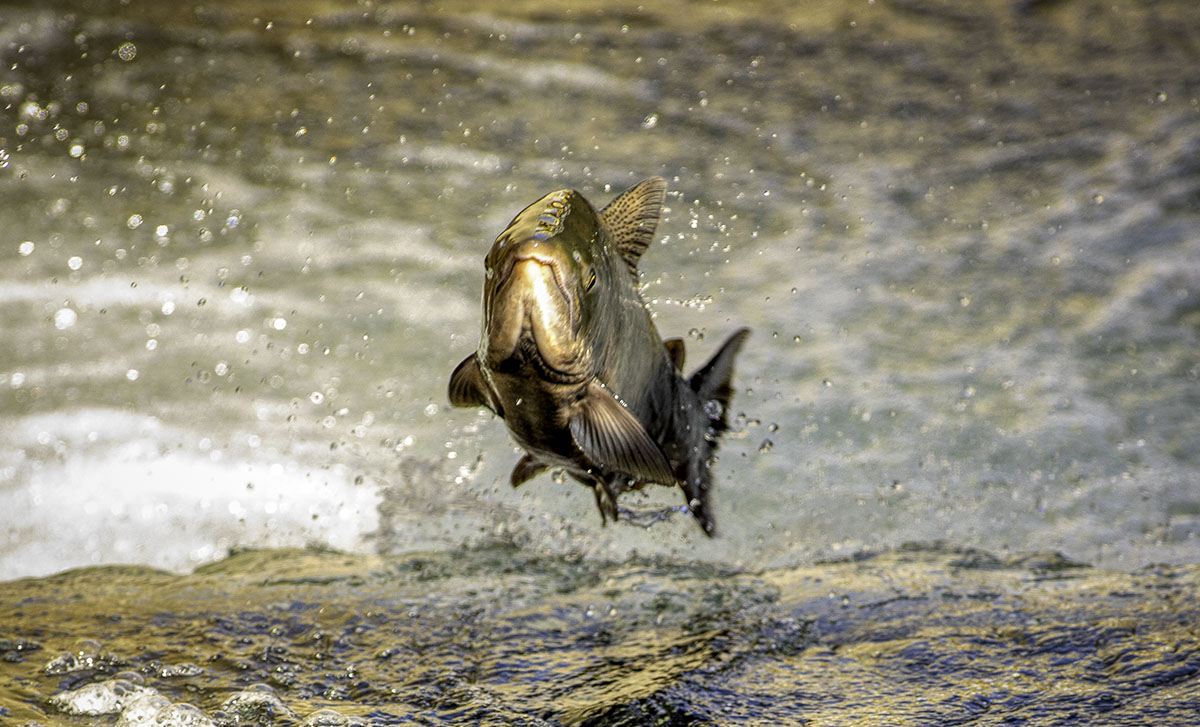Spotting salmon spawning by drone: Advancements in redd mapping
“Innovations that make current methods more accurate is one way in which science evolves. Researchers have recently done just that for mapping salmon spawning locations, or redds. Counting redds on a riverbed during the salmon spawning season allows for monitoring salmon population fluctuations, and determining habitat conditions that salmon consider favorable for laying their eggs. Commonly, redd mapping is done by manual field surveys or helicopters, and in recent years, by remote sensing using drones. In a new study published in the journal River Research and Applications, scientists made the first effort to test two types of remote sensing used with drones for surveying redds: red, green, blue (RGB) and hyperspectral imagery. ... ” Read more from FishBio here: Spotting salmon spawning by drone: Advancements in redd mapping
Tire-related chemical is largely responsible for adult coho salmon deaths in urban streams
“Every fall more than half of the coho salmon that return to Puget Sound’s urban streams die before they can spawn. In some streams, all of them die. But scientists didn’t know why. Now a team led by researchers at the University of Washington Tacoma, UW and Washington State University Puyallup have discovered the answer. When it rains, stormwater flushes bits of aging vehicle tires on roads into neighboring streams. The killer is in the mix of chemicals that leach from tire wear particles: a molecule related to a preservative that keeps tires from breaking down too quickly. … ” Read more from the University of Washington here: Tire-related chemical is largely responsible for adult coho salmon deaths in urban streams
Functional flows can improve environmental water management in California
“Over the past three years, a team of scientists from universities, NGOs, and state agencies across California have been working to provide guidance on how to better manage river flows for freshwater ecosystems throughout the state. A key product of this effort is the California Environmental Flows Framework (Framework), a guidance document and set of tools to help managers and stakeholders develop environmental flow recommendations for California’s rivers. The technical approach of the Framework relies on the concept of functional flows, defined as aspects of a river’s flow that sustain the biological, chemical, and physical processes upon which native freshwater species depend. … ” Read more from the California Water Blog here: Functional flows can improve environmental water management in California
Partnership protects endangered rabbit from fatal virus moving through California
“Under the hot summer sun, Eric Hopson, assistant refuge manager for the San Joaquin River National Wildlife Refuge, sets traps to capture live, endangered riparian brush rabbits on the refuge. Brown and white with a fuzzy cottontail, the riparian brush rabbit was once believed to be extinct, but a remnant population was discovered in San Joaquin County and reintroduced to the refuge. Recovery efforts improved the population, but the successful work could be derailed by a highly infectious virus that appeared in wild rabbits for the first time this spring. … ” Read more from US FWS here: Partnership protects endangered rabbit from fatal virus moving through California
How some trees survive the summer dry season
“An important component of Earth’s hydrologic cycle is transpiration—the movement of water through plants. Because transpiration affects near-surface temperatures, streamflows, and the productivity of ecosystems, understanding potential sources of subsurface moisture and how plants use them is crucial for developing accurate dynamic vegetation and land surface models. Our knowledge of these processes, however, is far from complete, in part because they are hidden below the ground. To better understand where trees get their water from, Hahm et al. studied Oregon white oaks (Quercus garryana), deciduous hardwoods that thrive in Pacific Northwest locales with thin soils underlain by highly weathered bedrock. … ” Read more from EOS here: How some trees survive the summer dry season
String of marine heatwaves continues to dominate Northeast Pacific
“During the summer of 2020, an area of unusually warm ocean water—a marine heatwave—grew off the West Coast of the United States. It became the second most expansive Northeast Pacific heatwave since monitoring began in 1982. The heatwave eventually encompassed about 9.1 million square kilometers, almost six times the size of Alaska, towards the end of September. In 2019 a similar heatwave developed slightly earlier in the year. While it was not as extensive as this year’s heatwave, its surface expression was warmer. It lasted 239 days, finally dying out way offshore in January 2020. … ” Read more from NOAA here: String of marine heatwaves continues to dominate Northeast Pacific
“Thirstier” atmosphere will increase wildfire risk out West
“Recent years have seen the largest, most destructive wildfires on record in California. Accompanying these extreme events have been extreme levels of evaporative demand—the degree to which the atmosphere “wants” to evaporate water from plants and the ground, regardless of how much water is available. A new analysis of global climate model simulations by McEvoy et al. suggests that evaporative demand will increase in California and Nevada through the end of the century, driving increased risk of more extreme wildfires and drought. … ” Read more from EOS here: “Thirstier” atmosphere will increase wildfire risk out West
Evaporation reverses groundwater flow and forms hyper-salinity
“The exchange of fresh water between a river and its floodplain can be altered by evaporation by lowering the water table and by increasing salt concentration. The rate of evaporation is affected by atmospheric demand for water, which is anticipated to increase with climate warming. America et al. [2020] use a numerical modeling experiment to quantify the potential relative roles of evaporation, both with- and without salt accumulation, on the development of freshwater lenses and water flow. … ” Read more from EOS here: Evaporation reverses groundwater flow and forms hyper-salinity
Report assesses promises and pitfalls of private investment in conservation
“The Ecological Society of America (ESA) today released a report entitled “Innovative Finance for Conservation: Roles for Ecologists and Practitioners” that offers guidelines for developing standardized, ethical and effective conservation finance projects. Public and philanthropic sources currently supply most of the funds for protecting and conserving species and ecosystems. However, the private sector is now driving demand for market-based mechanisms that support conservation projects with positive environmental, social and financial returns. Examples of projects that can support this triple bottom line include green infrastructure for stormwater management, clean transport projects and sustainable production of food and fiber products. … ” Read more from the Ecological Society of America here: Report assesses promises and pitfalls of private investment in conservation
About Science News and Reports: This weekly feature, posted every Thursday, is a collection of the latest scientific research and reports with a focus on relevant issues to the Delta and to California water, although other issues such as climate change are sometimes included. Do you have an item to be included here? Submissions of relevant research and other materials is welcome. Email Maven




